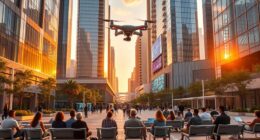AI still struggles to replace last-mile delivery roles that require physical effort, quick decision-making, and direct customer interaction. Delivery drivers, coordinators, and frontline staff handle complex routes, resolve unexpected issues, and engage with customers face-to-face—all tasks that need human judgment and physical dexterity. Managing safety, compliance, and real-time problem-solving remains challenging for AI. If you want to discover why these jobs remain irreplaceable, you’ll find key insights ahead.
Key Takeaways
- Complex route adjustments during traffic or weather disruptions require human judgment AI cannot replicate.
- Physical tasks like loading, unloading, and handling heavy parcels depend on human strength and dexterity.
- Personal customer interactions, resolving complaints, and building trust rely on emotional intelligence AI lacks.
- Regulatory compliance involving local laws, zoning, and safety protocols require local knowledge and judgment.
- Managing unpredictable on-the-spot issues such as missed deliveries or theft demands human problem-solving skills.

The last mile of delivery is where logistics and human effort come together most visibly. As a delivery driver or coordinator, you’re at the forefront of getting packages into customers’ hands, steering complex routes, and solving unexpected problems on the spot. Unlike automated systems, you make real-time decisions that influence customer satisfaction and delivery efficiency. Your primary role involves transporting packages from hubs to final destinations—whether homes or businesses—using vehicles that require careful loading and securing of items weighing up to 50 pounds. You rely heavily on GPS software to find the most efficient routes, but it’s your judgment that truly determines how smoothly each delivery goes. Interacting directly with recipients, you resolve issues like missed deliveries, wrong addresses, or damaged goods, which automation still struggles to handle effectively. Your ability to adapt to unforeseen circumstances is crucial in maintaining delivery timelines and customer trust. Additionally, your understanding of local regulations and traffic laws ensures compliance and safety during each delivery. You’re also the real-time problem solver. When traffic snarls or weather turns bad, your ability to adjust routes quickly is essential. You handle delays, address mismatches, or theft-related concerns on-site, often making quick, location-specific decisions that no algorithm can replicate. You’re also the real-time problem solver. When traffic snarls or weather turns bad, your ability to adjust routes quickly is essential. You handle delays, address mismatches, or theft-related concerns on-site, often making quick, location-specific decisions that no algorithm can replicate. Your adaptability keeps the delivery process moving, often under tight time constraints, and your skill in crisis management—like dealing with lost packages or security issues—guarantees that customers stay satisfied even when problems arise unexpectedly.
Human drivers navigate complex routes and solve delivery issues in real time, ensuring customer satisfaction beyond automation’s reach.
Behind the scenes, last-mile coordinators work tirelessly to optimize schedules, balancing driver workloads and fleet availability to meet tight delivery windows. They analyze routes, sometimes manually tweaking automated plans to save fuel, reduce emissions, and improve efficiency. They’re the link between warehouse teams, drivers, and customers, mediating disruptions and making sure everything runs smoothly. They manage tracking systems and oversee safety compliance, making sure drivers follow road laws and maintain vehicles properly. Their oversight helps prevent accidents and keeps the operation within legal parameters—roles that require human judgment and oversight that AI isn’t quite ready to replace. Moreover, their expertise in regulatory compliance ensures all legal requirements are met, which AI systems currently cannot fully handle due to the nuances of local laws. Customer service specialists focus on addressing complaints, correcting orders, and processing refunds through face-to-face or direct communication. Their personal touch builds trust and encourages repeat business, especially when they understand local logistics nuances—like steering rural versus urban delivery challenges. Their ability to adapt communication styles and understand cultural differences remains a human advantage.
Physical labor remains demanding. Loading, unloading, and arranging packages in vehicles require strength, dexterity, and endurance—factors that AI can’t replicate. Operating in extreme weather conditions adds another layer of difficulty, making human resilience essential. Meanwhile, regulatory compliance experts ensure all documentation is accurate, signatures are collected, and safety protocols are followed. They steer zoning laws, parking restrictions, and security procedures, applying local knowledge that AI tools can’t fully grasp. Cost optimization also depends on human input. Managing high volumes of small parcels, coordinating third-party carriers, and making manual route adjustments all contribute to controlling the last-mile expense—an area where human insight still outperforms automation. In sum, while AI and automation have transformed parts of last-mile logistics, roles requiring human judgment, flexibility, and personal interaction remain irreplaceable. [The ongoing integration of AI continues to complement these roles, but does not fully replace the human element.
Frequently Asked Questions
How Do Last-Mile Jobs Impact Local Economies?
You see that last-mile jobs boost local economies by creating thousands of new positions, often in logistics and support roles. These jobs increase wages, with each distribution center adding millions in annual income. As you participate in this growth, you help stimulate nearby businesses like retail and dining. The economic multiplier effect means your work supports broader community development, job opportunities, and improved local infrastructure, making these roles crucial to economic health.
What Training Is Needed for Last-Mile Delivery Roles?
You need to develop a mix of skills to excel in last-mile delivery. Start with safety training, including vehicle inspections and secure loading. Enhance your customer service and communication abilities to handle diverse interactions. Gain proficiency in routing software and local navigation. On-the-job training will refine your time management and emergency preparedness. This combination guarantees you meet safety standards, provide excellent service, and adapt quickly to dynamic delivery environments.
How Does Customer Interaction Influence Last-Mile Jobs?
Customer interaction shapes last-mile jobs by requiring you to handle complex requests, like rescheduling deliveries or clarifying instructions. You need to establish trust through personalized service, professionalism, and resolving disputes. Your flexibility in adjusting routes and managing unexpected issues ensures customer satisfaction. Additionally, you oversee technology, validating AI suggestions and addressing system failures. Your ability to communicate empathetically and adapt to unique situations keeps customers happy and loyalty strong.
Are There Safety Concerns in Last-Mile Logistics?
You should be aware that safety concerns in last-mile logistics are significant. Tight delivery windows, labor shortages, and urban congestion push drivers to take risks, like speeding or rushing through hazardous areas. Cost-cutting measures and outdated infrastructure further compromise safety. These factors increase the chances of accidents, injuries, and missed safety protocols, making it essential for you to prioritize safe driving practices despite the operational pressures.
What Innovations Are Emerging in Last-Mile Delivery?
You’re exploring innovations in last-mile delivery, like expanding logistics models with 4PL and 5PL providers managing entire networks, which improve efficiency through strategic coordination. Hybrid fleets combine autonomous vehicles and drones with human drivers, reducing costs. AI optimizes routes and forecasts demand, while micro-fulfillment centers and cross-docking streamline urban deliveries. These advances make delivery faster, more flexible, and sustainable, reshaping how goods reach consumers efficiently.
Conclusion
Despite AI advancements, last-mile jobs like delivery and personal assistance remain human-centric. You might find it surprising that 75% of consumers still prefer human interaction for complex or personalized services. This shows AI’s limits in understanding nuance and emotional cues. As technology evolves, these roles will likely stay human, emphasizing the irreplaceable value of personal touch. Keep an eye on these jobs—they’re the final frontier AI hasn’t conquered yet.









